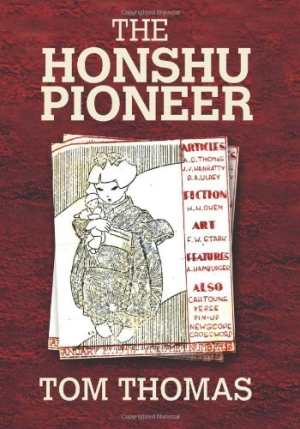The Honshu Pioneer
The U.S. Occupation of Japan and the First G.I. Newspaper
Tom Thomas’s The Honshu Pioneer deserves a wide readership of scholars and students of World War II and military history.
The Honshu Pioneer was the first American newspaper started by occupying American troops in Japan. In this book, Tom Thomas helps to document the brief but vibrant history of the previously obscure newspaper that would otherwise be lost in the dust of time. His salvage job, the product of a fortuitous discovery, captures the generation of men who fought World War II in their raw and only semicensored reality.
This book is a labor borne at least in part from filial loyalty. Thomas’s father, Arthur DeLong Thomas Jr., was one of the men who served in the 97th Infantry Division that helped to win the war against Germany, only to find their reward was to occupy the defeated Japanese mainland. There they started a newspaper in order to, at least in part, amuse themselves.
In June 2012, nearly eight years after his father’s passing, the younger Thomas found five months’ worth of still-preserved copies of The Honshu Pioneer in his father’s belongings. The soldiers were sometimes searingly honest in their depiction of their daily lives, in their criticism of American policies (with Thomas rightfully pointing out that similarly ruthless opinions would be nearly unimaginable in any military publication today), and even in their depiction of their superiors.
Thomas occasionally reproduces portions of the newspaper. Some of the best of these reproductions are of the cartoons — often ribald, sometimes scathing — that appeared in nearly every issue. But he mostly transcribes sections of it, and offers largely unobtrusive and often insightful commentary throughout. For example, he provides useful biographical notes on his father, giving some flesh and blood to the man who motivated him to produce the book.
The volume captures the tone of the newspaper, and thus of the American GI experience in Japan, while adding significant context and value in editorial asides. In the October 30, 1945, issue, Thomas’s father wrote in a column, “The only things [sic] missing from the community’s barber shop is a black boot boy, a striped pole, a Varga calendar and a brass spittoon.” The younger Thomas notes, “I was a bit jolted by that ‘black boot boy’ line, which would be completely out of character for the guy I knew, but I guess you have to remember time, place and community.” He then goes on to point out that this was the first column to appear in the paper with a byline and that he found it curious that his father used his father’s—Thomas’s grandfather’s—name rather than his own.
Because of his clear admiration for those young, battle-hardened men, Thomas largely stays out of the way, recognizing he has struck a rich vein with his material. This book deserves a wide readership of scholars and students of World War II and military history.
Reviewed by
Derek Catsam
Disclosure: This article is not an endorsement, but a review. The publisher of this book provided free copies of the book and paid a small fee to have their book reviewed by a professional reviewer. Foreword Reviews and Clarion Reviews make no guarantee that the publisher will receive a positive review. Foreword Magazine, Inc. is disclosing this in accordance with the Federal Trade Commission’s 16 CFR, Part 255.

